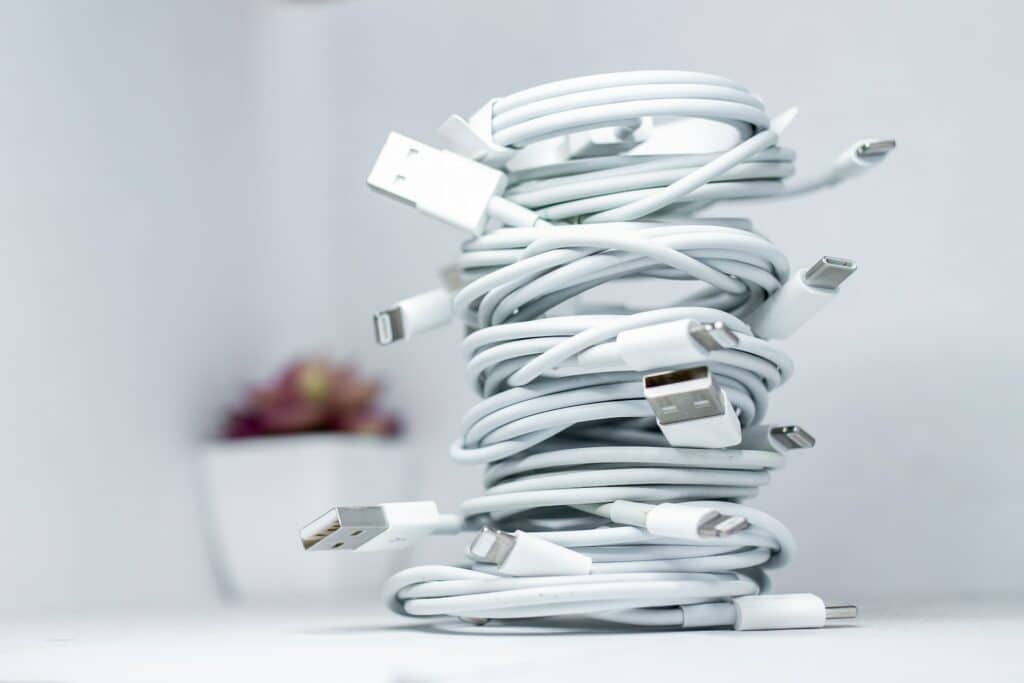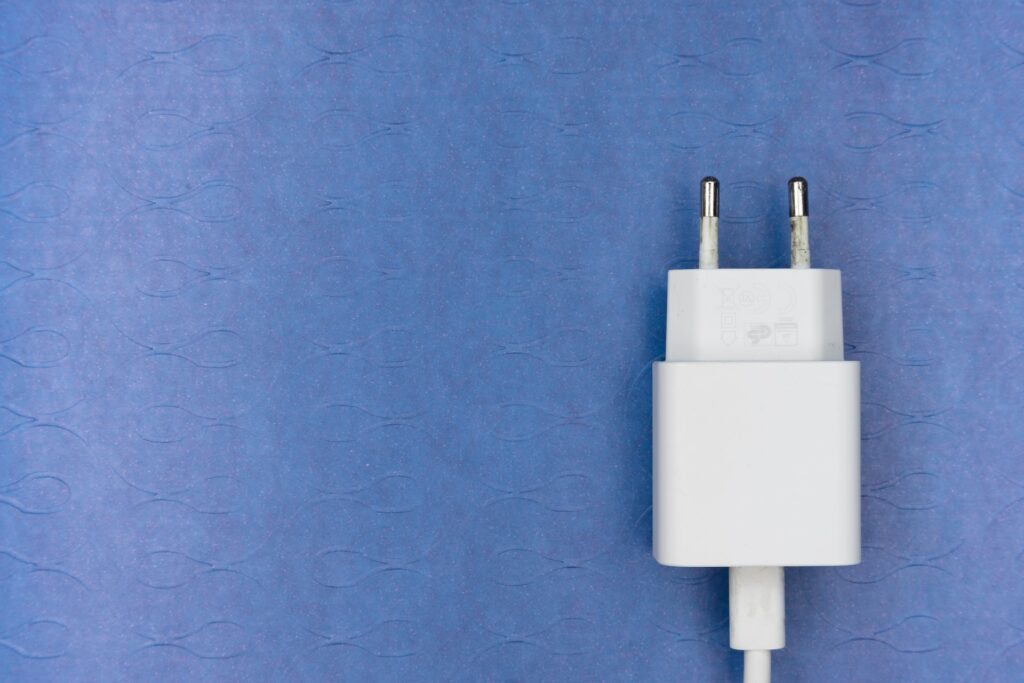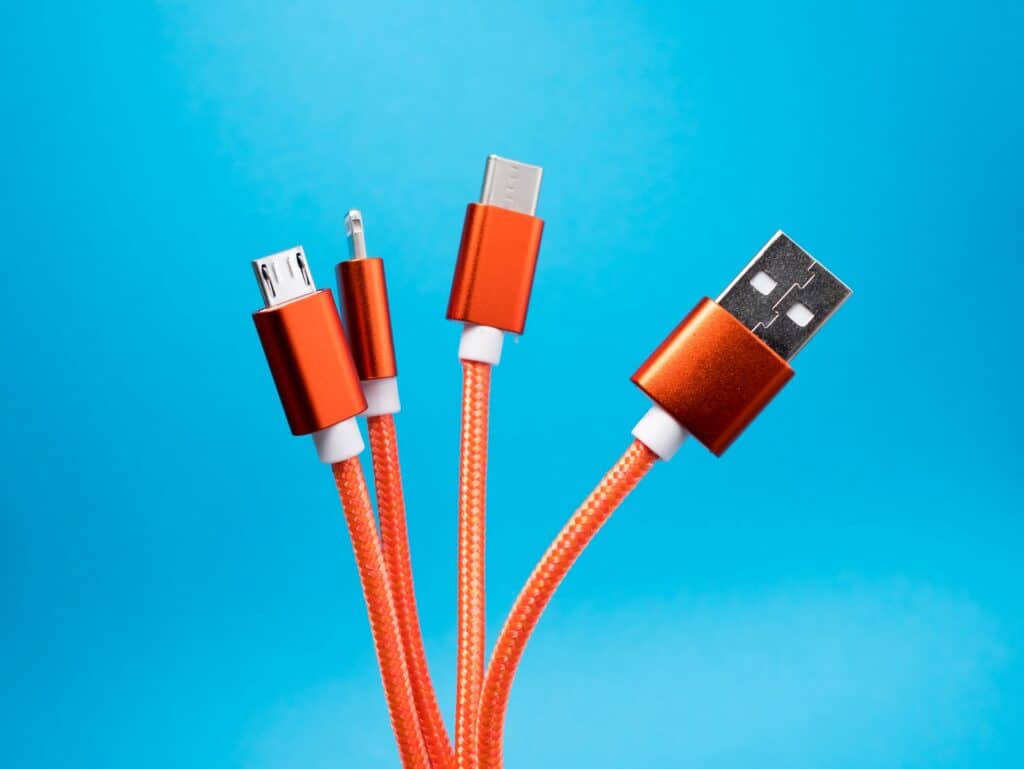When it comes to traveling, I’ve learned the hard way that not all chargers and cables are created equal. One of my biggest travel blunders was finding myself in an airport lounge with a dead phone and a charger that simply didn’t fit the outlets. That’s when I realized how important it is to have the right gear for your tech needs while on the go.
Now, let’s talk about finding the perfect chargers and cables for your travels. It’s not only about making sure your devices stay powered up, but also ensuring compatibility with different outlet types across the globe. And let’s not forget durability — you don’t want a flimsy cable giving out on you mid-flight!
So here we go! My traveler’s tech guide will help you navigate through picking just what you need to keep your devices charged up and ready, no matter where your journey takes you. Remember: being prepared can make or break your trip, especially in this digital age!
Understanding the Importance of Quality Chargers and Cables

I’m sure we’ve all experienced it at some point – that sinking feeling when your phone battery is flashing low and you’re miles away from home. It’s in these moments that we truly appreciate the value of a good charger. But not just any charger will do. Quality matters.
So, why should you invest in quality chargers and cables? For starters, they ensure safe charging for your devices. Inexpensive chargers may seem like a bargain initially, but using them can lead to issues such as overheating or even permanent damage to your gadget’s battery life over time.
Another reason to opt for quality chargers and cables is their durability. Imagine you’re on a trip of a lifetime, capturing every moment on your phone or camera only for your charger or cable to stop working because it couldn’t stand up to the rigors of travel.
Let’s talk numbers here:
| Type | Failure Rate |
| Cheap non-branded chargers | 63% |
| Premium branded chargers | 6% |
As this data reveals, cheap non-branded chargers have an alarmingly high failure rate when compared to their premium counterparts.
In addition, quality chargers and cables offer better performance – faster charging times, efficient power transfer, and longer life span are just some benefits you’d enjoy. Do not forget about compatibility too! High-quality products often come with wide-ranging compatibility across various device models and brands.
- Safe Charging
- Durability
- Better Performance
- Wide Compatibility
These four factors alone underscore why investing in reliable products is essential. Remember: when it comes to tech accessories like these, it’s always better to play safe than sorry!
Navigating the Tech Market: Choosing the Right Charger

Let’s dive into picking the right charger for your travel needs. It can seem like a daunting task with so many options available, but I’ll guide you through it.
First things first, compatibility is key. Not all chargers are created equal and it’s crucial to ensure that the charger you choose pairs well with your devices. For instance, an Apple iPhone won’t charge with a micro USB charger – it needs a lightning cable. Android phones, on the other hand, generally use either micro USB or USB-C connectors. So, before hitting that purchase button online or in-store, double-check your device’s charging port type.
Secondly, power output matters. This is measured in watts (W) and determines how quickly your device will charge. Standard chargers typically offer around 5W of power but if you’re looking for faster charging times – especially handy when time is precious on the move – look out for chargers advertised as ‘Fast Charge’, supplying up to 18W or more.
Next up is portability. When traveling light is important, bulky chargers simply won’t cut it! Look out for slim designs and foldable plugs that make packing them away easier.
Lastly, don’t forget about safety standards! Trustworthy brands adhere to rigorous safety regulations and offer features such as overcharge protection or automatic shut-off after full charge to protect your devices from damage.
Here are some pointers:
- Check compatibility – does the charger fit your device?
- Consider power output – do you need fast charging capabilities?
- Think about portability – will it pack easily without adding unnecessary weight?
- And finally safety standards – does the brand have good reviews and adhere to safety protocols?
Choosing the right charger doesn’t have to be complicated; armed with this knowledge you’ll be able to navigate those tech aisles like a pro!
Different Types of Travel-Friendly Chargers
Traveling is a blast, isn’t it? But there’s one thing that can quickly turn your dream vacay into a nightmare: running out of battery on your essential gadgets. Fear not! I’m here to shed some light on the different types of travel-friendly chargers.
A great option for those constantly on the go is the power bank or portable charger. These compact devices pack quite a punch and come in various capacities, from 5,000mAh up to 20,000mAh and beyond. They’re designed to provide multiple charges for your smartphone or tablet before needing a recharge themselves. And let’s not forget their versatility – many models now cater to laptops and even certain gaming systems!
Next up are solar-powered chargers – perfect for camping trips or locations where outlets might be scarce. By harnessing sunlight energy, these marvels keep your devices juiced up without needing an electrical supply.
And then we’ve got wall chargers with international compatibility – an absolute must-have if you’re jetting off abroad. These handy gizmos are designed with interchangeable plugs fitting sockets in Europe, Asia, America, and more! No need to worry about lugging around numerous adaptors anymore.
Finally, let’s talk about car chargers – they’re lifesavers during long road trips when your GPS decides it’s had enough halfway through the journey! They plug into your vehicle’s cigarette lighter socket and provide USB ports for charging.
Let me emphasize that all these chargers have their pros and cons depending upon what type of traveler you are. So next time you’re packing for an adventure; don’t forget to choose wisely from this smorgasbord of options.
Selecting Durable Cables for Your Devices
I’ve come across a lot of travelers who focus intently on getting the best tech gadgets but overlook the importance of high-quality cables. Trust me, investing in durable and reliable charging cables is equally important when planning your travel tech kit. It’s an easy miss but can have a significant impact on your travel experience, especially if you’re heavily reliant on electronic devices like smartphones, tablets, or laptops.
Choosing the right cable doesn’t just mean picking any wire that fits into your device; it demands more attention than that. You’ll want to look at factors such as durability, length, compatibility, and speed. For instance, braided nylon cables are generally more robust than standard plastic ones and can resist tangles better.
Here are some features you should be looking for:
- Durability: Look for cables with reinforced stress points since they endure daily bends and twists better.
- Cable Length: If you’re going to charge your device from a distance or while using it (say in bed), opt for longer cables.
- Compatibility: Ensure that the cable is compatible with your device model before purchasing it.
- Speed: A decent-quality cable should support fast-charging capabilities.
Remember to avoid buying no-name brands from obscure shops. They may seem like a bargain initially but often fail in performance after only a few uses. And there’s nothing worse than being stuck somewhere unfamiliar with a dead phone battery!
In a world where USB-C is becoming commonplace among new devices, having one handy during travels could prove beneficial. These USB-C cables offer faster data transfer speeds and support higher wattage power delivery which means quicker charging times – perfect for those always on-the-go moments.
While picking up these types of chargers might sound simple enough, it’s crucial not to underestimate their importance in our increasingly digital lives! As I’ve learned from my own experiences (and mishaps!), investing in high-quality charging cables can save you a lot of frustration on the road. So, next time you’re packing your tech gear, make sure your cables are up to par!
How to Identify High-Speed Charging Cables

I’ll admit it, deciphering the world of charging cables can be a bit daunting. But don’t fret! I’m here to walk you through some key factors that’ll help you identify high-speed charging cables.
First off, let’s talk about USB standards. It’s essential to know that not all USBs are created equal. The standard has evolved over the years, with more recent versions offering faster data transfer and charging speeds. For instance,
- USB 2.0: This might be the most common type out there, but it’s not your best bet for speedy charging.
- USB 3.x: A significant step up in terms of speed compared to its predecessor.
- USB-C: This is the latest and greatest in the bunch, capable of delivering power at an impressive rate.
To further illustrate this point:
| USB Type | Data Transfer Rate |
| USB 2.0 | 480 Mbps |
| USB 3.x | 5 Gbps |
| USB-C | 10 Gbps |
Next on our list is cable length. You might think a longer cable would be more convenient—after all, who doesn’t love being able to charge their device from across the room? However, when it comes to fast charging times, shorter is definitely sweeter.
Lastly, pay attention to wattage ratings if you’re looking for a quick juice-up. Higher wattage means faster charging—simple as that!
Consequently:
- A typical phone charger provides around 5 watts
- Fast chargers go up to around 18 watts
- Ultra-fast chargers can reach up to whopping 100 watts
Here’s how they stack up:
| Charger Type | Wattage |
| Typical | 5W |
| Fast | 18W |
| Ultra-fast | 100W |
In a nutshell, when you’re out hunting for high-speed charging cables, remember to check the USB standard, keep an eye on cable length and always consider wattage ratings. Happy shopping!
Packing and gear tips:
- Digital Nomad Packing List: The Ultimate Guide to Traveling Light
- Best Walking Shoes for Men: Top Picks
- Best Camera Lenses for Travel Photography: Tips For Your Next Trip
- Travel Accessories for Women: Best Items For Your Next Trip
- Best Backpacking Tent: The Ultimate Guide
- Best GoPro Alternative: The Ultimate Guide
Pairing Your Devices with the Perfect Charger and Cable
I’ve come across a startling number of travelers who have faced the frustration of device connectivity issues on their trips. They’re left with an unusable device simply because they didn’t bring the right charger or cable. So, let’s dive into how you can avoid this predicament.
Firstly, it’s essential to know your device specifications before selecting any charger or cable. Every device has a unique power requirement and connector type – be it micro-USB, USB-C, Lightning, or something else entirely. I highly recommend checking your device manual or looking up its specs online to ensure you’re pairing it with compatible accessories.
Consider these examples:
- The latest Apple devices use Lightning cables for charging and data transfer.
- Many Android phones use USB-C cables which are faster and more efficient than their predecessors.
- Older models might still require a Micro-USB cable.
Secondly, we need to talk about power output. Chargers vary significantly in their wattage – from 5 watts phone chargers to 85 watts laptop chargers. You’ll find this information usually printed on the charger itself as ‘Output’. It’s crucial not just for charging speed but also for safety reasons that you match your devices with an appropriate power source.
Lastly, always opt for quality over price when choosing chargers and cables. Counterfeit products may seem like a bargain until they fry your expensive gear due to poor build quality and lack of safety standards!
So there you go! It isn’t rocket science but just being aware of what your devices need can save you some serious headaches (and heartaches) when traveling. Remember: Know your gadget before hitting the road! The perfect travel buddy could be as simple as the right charger and cable combo!
Common Mistakes to Avoid When Buying Chargers and Cables
When it comes to buying chargers and cables for travel, I’ve seen countless travelers fall into common pitfalls. Let’s delve into these mistakes, so you can avoid them on your next tech purchase.
Firstly, let’s talk about the importance of checking compatibility. Many people assume that all cables are created equal – they’re not. For instance, you might find yourself snapping up a cheap cable only to realize it doesn’t fit your device. It’s crucial to check whether the charger or cable is compatible with your device before purchasing.
Next up is ignoring power output. Not every charger provides the same amount of juice. Some might charge your phone in an hour, while others could take half a day! Be sure to look at the wattage – usually denoted ‘W’. As a rule of thumb: The higher the wattage, the quicker it’ll charge your device.
The third mistake I often see is overlooking cable length. A super-short cable may be compact for travel but if it means you’re stuck sitting on the floor next to an outlet… not ideal! On the flip side, excessively long cables can also be a hassle as they tend to tangle easily and add unnecessary weight to your luggage.
Another blunder is falling for counterfeit products. They may seem like a bargain at first sight but they’re often poor quality and can even pose safety risks such as overheating or fire hazards. Always buy from reputable retailers and avoid deals that seem too good to be true!
Lastly, don’t forget about multi-device charging options if you carry multiple gadgets when traveling! A wall charger with several USB ports or a universal charging station can save space in your bag and also make life easier by allowing you to charge multiple devices at once.
By avoiding these common mistakes when buying chargers and cables, you’ll set yourself up for stress-free travels knowing that all your tech needs are covered!
Wrapping Up: Picking the Best Chargers and Cables
I’ve spent a considerable amount of time talking about various types of chargers and cables. My aim has been to equip you with enough knowledge to make an informed decision when purchasing these essential travel tech accessories. Now, it’s time for me to wrap up my insights and recommendations.
Picking the best charger largely depends on your specific needs. You’ll want one that’s compatible with your devices, efficient, and convenient for travel. I’d recommend going for a multi-port USB charger if you have multiple gadgets. It’s space-saving and you won’t have to carry different chargers around.
When it comes to cables, durability should be your top priority. No one wants a cable that frays or breaks easily! Look out for nylon-braided ones as they’re generally more robust. Also, remember to consider length – while longer cables provide flexibility in use, they can also add extra bulk to your bag.
A few quick takeaways:
- Always check compatibility before buying.
- Multi-port USB chargers are great for those traveling with multiple devices.
- Durability is crucial when choosing cables – nylon-braided ones are often a good pick.
- Balance out cable length based on your needs and comfort while traveling.
Traveling can be stressful enough without worrying about running out of battery power or dealing with faulty wires! So investing in quality chargers and cables is worth every penny in my book.
Remember this: The right tech gear not only enhances the ease of your trip but also its enjoyment factor! Safe travels everyone!



